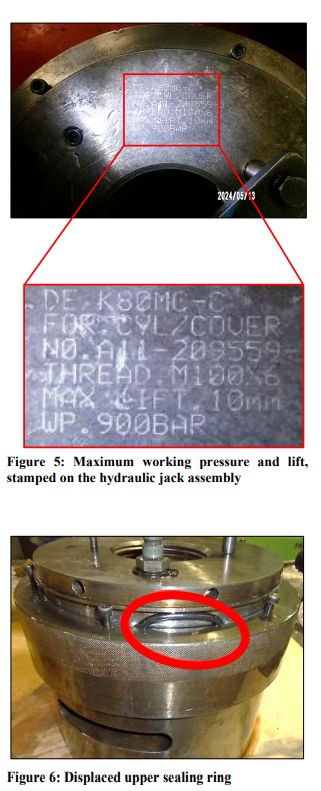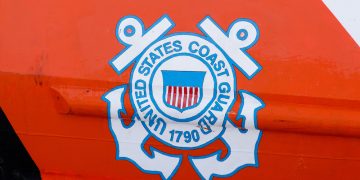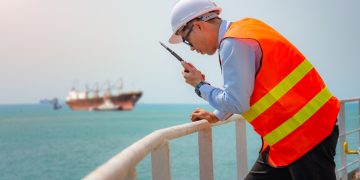Transport Malta’s Marine Safety Investigation Unit has issued an investigation report into an incident where a third engineer on a container vessel was seriously injured in the engine room.
The incident
On 21 October 2023, whilst the container vessel CMA CGM San Antonio was alongside a layby berth at Jebel Ali, one of the two third engineers was seriously injured in the engine-room during the untightening process of main engine cylinder head no. 5. Crew members assisted the third engineer and administered first aid on board. However, the injuries to his face were serious enough to warrant admission in a shore hospital for further treatment. Following the necessary treatment, the third engineer was repatriated.
The hydraulic jack sealing arrangement and maximum piston lift
As for any hydraulic jack, the one used on CMA CGM San Antonio had a maximum lift value stamped on it. The maximum lift on this hydraulic jack was 10 mm. The operations manual cautioned that beyond this maximum travel, the lower sealing and back-up rings may be damaged and would have to be replaced.
A photo taken soon after the accident showed the upper sealing ring displaced from its recess on the moving piston. The retrieved parts (which have been sent to the metallurgical lab) had a small part (about 50 mm in length), which had broken off and was missing. The disassembly of the hydraulic jack after the accident revealed no damages. The safety investigation did not exclude that the injuries to the crew members could have been caused by the missing part of the back-up ring. However, it was considered also possible that the injuries may have been caused by the leaking hydraulic oil under the pressure build-up, being generated at the time by the jack to stretch the stud.
Equally important to consider, was the cause of the displaced sealing ring. The upper sealing ring could not be displaced out of its recess because of the stationary cylinder walls unless:
- the working pressure exceeded 900 bar, the safety drain passages were blocked, and the maximum lift of 10 mm was exceeded;
- the back-up ring was damaged and could not support the upper O-ring when subjected to the hydraulic oil;
- the clearance between the piston and the cylinder exceeded the 3.0 mm stipulated in the operations manual; or
- a combination of these factors.

Exceeding the maximum working pressure was not considered to be the most plausible option. The hydraulic jack assembly was designed not to exceed this pressure. Pressure relief orifices would align with the oil chamber below the moving piston, relieving the pressure below the hydraulic jack. Moreover, crew members who were on site recalled that the working pressure at the time had only reached 50% of the maximum. The other possibilities appeared more plausible, although no accident data was available to confirm the precise dynamics.
The importance of the back-up ring is critical to support the O-ring when the assembly was subjected to the working pressure. To this effect, the safety investigation did not exclude the possibility that the back-up ring had been damaged before the accident (and went unnoticed by the crew members), and consequently failed during the application of the working pressure, resulting in the O-ring being pushed out of its recess and popping out of the moving piston.
The safety investigation also took note of the importance of the clearance between the stationary cylinder and the moving piston before hydraulic oil pressure is applied. The instruction manual specified that for a maximum lift of 10 mm, the clearance between the two hydraulic jack assembly components was 3 mm. The clearance had to be measured by a feeler gauge. If this clearance was not adhered to and perhaps even exceeded, the moving piston lift could then reach a position high enough for the upper O-ring to pop out of its recess. A combination of these two factors was not excluded either.
Sealing arrangements in the hydraulic jack
Instructions on the manufacturer’s manual specified that both sealing rings had to face each other when mounted on the moving piston and the stationary cylinder. This was critical because the back-up ring’s function was to support the sealing ring to withstand the tremendous pressures generated when the hydraulic jack was operated. The safety investigation did not come across accident data which suggested that the sealing and back-up rings had been mounted incorrectly, following the previous use of the tool. Therefore, this was not considered a contributing factor to the accident.
The hydraulic fluid
The instructions on the manual also specified the type of hydraulic oil, which had to be used, cautioning further that the use of other types of oils, especially those which are normally alkaline, could damage the back-up rings. It was confirmed that the hydraulic fluid used was Gulfsea Hydraulic Oil 32. The chemical properties of the fluid met the criteria stipulated by the manufacturers of the hydraulic jack and therefore, the type of hydraulic fluid in use was not considered as a contributing factor to this accident.
Results from the lab
The damaged sealing and back-up rings were sent to a metallurgical laboratory for analysis. For comparison purposes, new O-rings were also sent to the laboratory. Shore hardness testing was carried out using Bareiss Digi Test durometer. Measurements were taken on the O-ring samples on both the surface and on the previously cut cross-sections. Moreover, a Fourier-transform infrared (FTIR) spectroscopy was carried out to obtain a unique IR spectrum, reflecting the materials’ chemical makeup. Attenuated total reflectance Fourier-transform infrared spectroscopy was carried out. The hardness data and the infrared spectra of both O-ring samples confirmed that the O-rings were virtually identical with no indicator of change or degradation being detected.
Risk prediction and assessment
Risk prediction, assessment and control are considered to be the cornerstones of any safety management system. The risk assessment documents made available to the safety investigation did not suggest that the hazard related to the maximum lift had been picked up and therefore, the risk was not considered and mitigated by the two crew members doing the assessment. The safety investigation was cognisant that the hydraulic jack was used regularly. In fact, prior to the accident, the jack had been used for the overhaul of an exhaust valve on the main engine. That suggested that the crew members were aware of the 10 mm maximum lift, imposed by the manufacturers.
It has to be submitted that it may not be possible for individuals doing the risk assessment to foresee all possible events, which may eventually lead to the accident. The risk assessment exercise, in which the hazard and risk could have potentially been addressed, was under the job description “overhaul main engine piston on Unit No. 5,” – Job step: liner, cylinder cover, cylinder head. The safety investigation was of the view that very typical of risk assessment exercises, given that the core activity described in the document was the overhaul of the piston (rather than the overhaul of the cylinder head), it appeared that the step had not been considered during the exercise. Missing on this step may have also been made more possible if the list of hazards, risk and control measures had not been evaluated with other crew members, who already had experience of main engine units’ overhaul. The safety investigation did not come across any information, which suggested that the (draft) document had been discussed with other crew members.
Conclusions
- The upper sealing ring of the hydraulic jack became displaced from its recess, leading to an injury to the crew member.
- The safety investigation did not exclude the possibility that the back-up ring had been damaged before the accident and went unnoticed by the crew members.
- The possibility of excessive clearance between the two hydraulic jack components was not excluded. If so, the moving piston lift could reach a position high enough for the upper O-ring to pop out of its recess.
- The risk assessment documents made available to the safety investigation did not suggest that the hazard related to the maximum lift had been picked up.
- The failure of the O-rings was neither attributed to its quality nor to material degradation.





























































